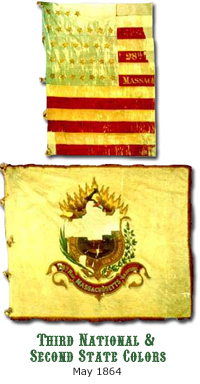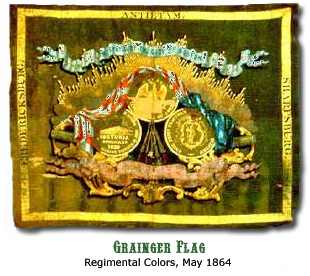Flags
of the 28th Massachusetts (conclusion)
 rom this
point on, no one really knows which
of its two green regimental flags the 28th Massachusetts carried: the
fine embroidered Tiffany flag or the replacement Irish color from
Boston. As a unit of the Irish Brigade, which by this time had won
considerable laurels, the 28th might have chosen the
Fredericksburg-christened Tiffany over the Pilot flag replacement.
Absent evidence to the contrary, it is assumed that the regiment
carried its second national color and Tiffany flag at:
Chancellorsville, Gettysburg, and Mine Run in 1863, and Wilderness, Po
River, and Spotsylvania in 1864.
rom this
point on, no one really knows which
of its two green regimental flags the 28th Massachusetts carried: the
fine embroidered Tiffany flag or the replacement Irish color from
Boston. As a unit of the Irish Brigade, which by this time had won
considerable laurels, the 28th might have chosen the
Fredericksburg-christened Tiffany over the Pilot flag replacement.
Absent evidence to the contrary, it is assumed that the regiment
carried its second national color and Tiffany flag at:
Chancellorsville, Gettysburg, and Mine Run in 1863, and Wilderness, Po
River, and Spotsylvania in 1864.
 During the winter and spring of 1864,
Col. Richard Byrnes was back in Massachusetts with several other
officers on recruiting duty. Toward the end of his visit, Gov. Andrew
on April 22 presented Byrnes with yet another set of colors: the third
national flag and second regulation state flag issued to the unit.
During the winter and spring of 1864,
Col. Richard Byrnes was back in Massachusetts with several other
officers on recruiting duty. Toward the end of his visit, Gov. Andrew
on April 22 presented Byrnes with yet another set of colors: the third
national flag and second regulation state flag issued to the unit.
This third national color was the same size
as the second, which it would replace in the field, but it had a much
lighter blue canton, known at the time as "Old Glory" blue.
The new state flag had a gold fringe and a
slightly different state emblem in the center that was common issue
during the last year of the war, but like the 28th's first state flag,
was never carried by the regiment in the field and likely was not even
taken back to Virginia.
Just before Byrnes was
about to depart
Massachusetts to rejoin his unit, Boston Mayor Frederic W. Lincoln Jr.
presented him with the regiment's third green Irish flag. The design in
the center was different from the earlier flags, but mimicked their
Irish imagery and patriotic motifs.
There was a gold band around the edge of the
flag recalling the 28th's early battle honors. Interestingly, these
included separate listings of "Antietam" and "Sharpsburg," which of
course are alternate names for the same battle. Apparently, the
designer of the new green flag misinterpreted a letter that Capt.
Sanborn had written the previous winter, recounting the regiment's
battles as "James Island, Bull Run, Chantilly, South Mountain,
Sharpsburg & Antietam, and Fredericksburg."
 The
third national color must have quickly replaced the second, since it
bore considerable evidence of field use. The new flag was likely
carried proudly at Cold Harbor, Petersburg, First and Second Deep
Bottom, Reams' Station, Hatcher's Run (Petersburg), and ultimately
during the triumphant march down Pennsylvania Avenue in Washington,
D.C., in the May 23, 1865, Grand Review that celebrated the war's
conclusion.
The
third national color must have quickly replaced the second, since it
bore considerable evidence of field use. The new flag was likely
carried proudly at Cold Harbor, Petersburg, First and Second Deep
Bottom, Reams' Station, Hatcher's Run (Petersburg), and ultimately
during the triumphant march down Pennsylvania Avenue in Washington,
D.C., in the May 23, 1865, Grand Review that celebrated the war's
conclusion.
On the other hand, the third green Irish
flag may never have seen service. In 1925, the family of Charles
Grainger, a veteran of the 69th New York, donated this flag to the
Commonwealth of Massachusetts. For reasons still unknown, Grainger
claimed to have taken it home after the war.
Since it is hard to fathom one regiment
entrusting one of its battle flags to a soldier from another unit, for
any reason, historians speculate that Grainger came across this green
flag in storage, kept it hidden, and took it home as a souvenir without
raising any suspicion among surviving members of the 28th. Whether
Grainger deserves the notoriety or not, the flag still bears his name
to this day.
The eight surviving flags of the 28th
Massachusetts are in the collection of the State Archives in Boston,
which provided the images seen on these pages.

Based
on an article originally written by Steven Eames, with research
assistance from Steve Hill, and contributions from Don Williams and
Jason Gauthier.

